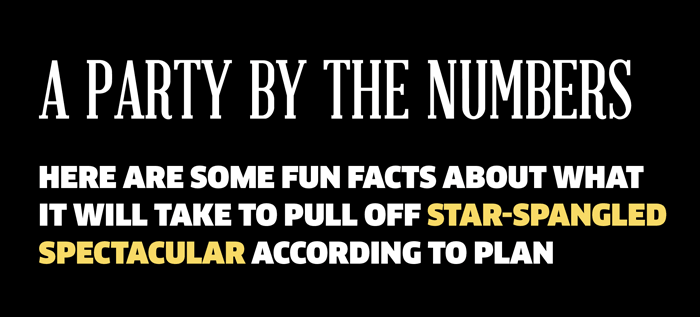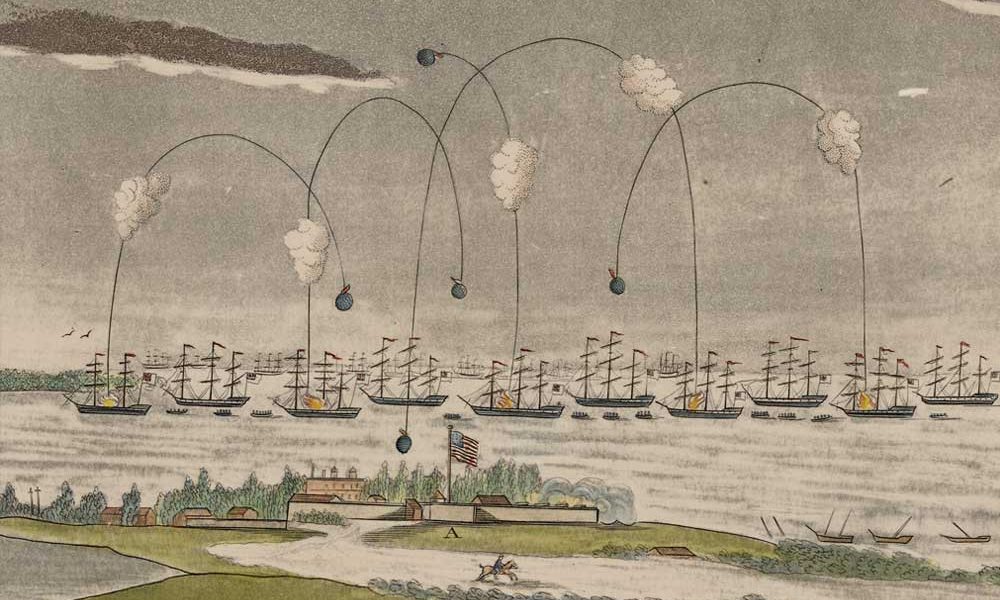History & Politics
Let's Party For The Patriots
Baltimore’s giant 1814 bicentennial bash promises to break all the records.
What has 36 ships, a formation of Navy F-18s, seven fireworks barges, 98,000 fireworks effects, and 1.5 million spectators?
If all goes according to plan and the weather cooperates, the answer will be this month’s massive Star-Spangled Spectacular, an encore of the party extraordinaire held two years ago to mark the start of the War of 1812 and which proved one of Charm City’s most successful events on record. After it brought in $166 million in direct spending, it got city officials thinking, “Hey, wait, we could do this again, right?”
So, okay, sure, but what are we celebrating now? That would be the 200th anniversary of the actual Battle of Baltimore (and the writing of what became our national anthem), a defining moment in the war in which British forces, after routing American militia at Bladensburg and burning Washington, D.C., tried to take Baltimore from two sides, by sea and by land.
Barred from the harbor by the tenacious garrison at Fort McHenry and stopped after their march up North Point Road by a ragtag force of 15,000 American militiamen, seamen, and assorted other volunteers (including aged Revolutionary War vets), the redcoats unwittingly gave troublesome Baltimore an excuse for yet another grand party this month.
It’s a bash that promises to outdo even the nearly flawless celebration in 2012, so the only questions now are: What? When? And where? Lucky for you, we’ve got the answers.
How it All Came Together
The 1812 celebration two years ago holds the title of the largest free public event in Maryland ever, but it could very well be topped by this month’s massive Star-Spangled Spectacular.
When it rolls out, though, most onlookers will have little concept of what goes into a bash this big: It’s an event that has given a whole new meaning to the phrase “party planning.”
For more than a year, 80-plus agencies, guided by Ann Beegle, executive director of the nonprofit Star-Spangled 200 agency, and Bill Pencek, executive director of the state’s 1812 bicentennial commission, have been painstakingly making the preparations.
A climax to a series of historical events that have been going on all year in towns up and down the bay that were touched by the war—from Bladensburg and Benedict to Leonardtown and Havre de Grace—the event requires collaboration by city, state, county, federal, and military officials, as well as scores of nonprofits and contractors, from film producers to fireworks experts.
And how much does this thing cost? When all is said and done, the tab for the party will be about $17 million, but some of that is covered by corporate sponsorships from companies that have a little something to gain from the exposure. (Think your AT&T, Constellation Energy, or Papa John’s logo being picked up by TV cameras all over town, to name just three of them.)
To understand the complexity of crafting all these elements into a successful and perfectly timed event (if anybody’s counting, it will have taken 182 planning meetings to make this happen), you would have to have been a fly on the wall at one of several regular meetings held by the dozens of agencies involved, such as the six-hour one held in May in the spacious and well-appointed headquarters of the Maryland Pilots Association (the skippers-for-a-day who guide merchant ships up the Chesapeake).
Picture 50 people from nearly as many agencies and governments seated in rows, plus a handful more on speakerphone. (On the line during the entire meeting are representatives from the U.S. Navy, the Maryland National Guard, the mayor’s office, and the Baltimore County executive’s office.) Presiding over the whole thing at the front of the room are Beegle and Pencek, who play schoolmarms, checking with each pupil to make sure they did their homework from the last class.
First called on is Mike McGeady, president of Sail Baltimore and co-chair of the Waterways Planning Group, who reports on his “barge-sourcing,” a search up and down the East Coast for seven fireworks barges that can be towed to different spots around the harbor and the Patapsco River so that the over-the-top pyrotechnics display will be visible from virtually any vantage point from the Inner Harbor to Fort McHenry. And you can’t just randomly drop 14 barge anchors onto the bay floor over buried utility lines or the casing of the harbor tunnel, which means working with the U.S. Coast Guard, the U.S. Army Corps of Engineers, and Maryland environmental regulators. McGeady’s also in charge of working with the Baltimore City Marine Police and the Coast Guard to control private boats that are sure to show up in droves.
 view the infographic
view the infographic
And who is to look after the 2,500 randy sailors from the visiting tall ships and naval vessels, including U.S., British, and German warships that have been invited to the party? That would be Sail Baltimore vice president Nan Nawrocki, who has organized soccer, softball, and rugby matches for them, secured restaurant and event discounts, and is lining up a fleet of crew buses to shuttle them around town, from the piers at Locust Point to the downtown to Fort McHenry.
Mike Harrington from Baltimore City’s government reports on tourist parking locations and plans for shuttle buses to Fort McHenry (private cars won’t be able to drive there), while Pencek and the Baltimore Office of Promotion and the Arts are charged with securing hundreds of Port-a-Potties for all of the parking lots.
Then, there are status reports on the concurrent Fort McHenry air show originating at Martin State Airport, which will require EMS tents, hospitals on standby, FAA okays for the air show over the fort, security protocols imposed by the Navy for their Blue Angels crews and aircraft, and specific police, fire, and EMS units assigned to the event.
Also on the to-do list is organizing a living flag of more than 7,000 kids from every county in Maryland, finding 200 more buses to get them there, and recruiting 500 volunteers to organize them. Not to mention coordinating radio communications between all the players, from the Coast Guard and the National Park Service to the fire department and the city police.
So what if we threw a party and nobody came? That’s where Star-Spangled marketing maven Jill Feinberg comes in, rattling off recent national media exposure ranging from USA Today and travel magazines to inflight and Amtrak publications.
Oh, and you’re going to be on national TV, too, Baltimore, so let’s make sure we have the Old Bay wiped off our face and our fly is zipped up. Choreographing the event for television requires another subgroup meeting later in the day, with representatives from Showcall, a national event planner, Fireworks by Grucci, Dick Clark Productions, Maryland Public Television, PBS, and park rangers from the fort.
They must script every detail for the multiple cameras (including one mounted atop the Domino Sugar factory) and the several Jumbotrons that will be placed all around the harbor from Pier 6 and Harborplace to the fort. The split-second timing details (let’s not have any TV dead time, please) include the arrival—presumably by helicopter— of the governor and the President, the flag ceremony, the usual speechmaking, the singing of the national anthem, and exactly when the Grucci pyromaniacs on the barges will put the match to the largest fireworks display Baltimore has ever seen. (Some will also be launched from the tops of buildings.)
Despite the mind-boggling number of details to work out, though, Beegle isn’t worried.
“All the players had a major dress rehearsal in 2012, and we work together well, so that’s a real benefit,” she says.
“Some people might ask, ‘Why bother?’” says Pencek. “The answer is, ‘Because it’s our most important national heritage story.’ All we have to do is figure out how to roll all that up so that when the event is over, we’ve educated Baltimoreans and told the nation where these icons came from.”


